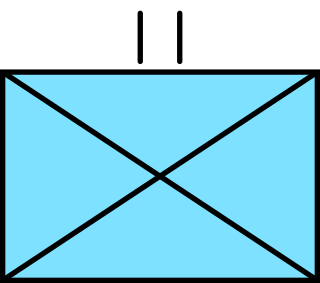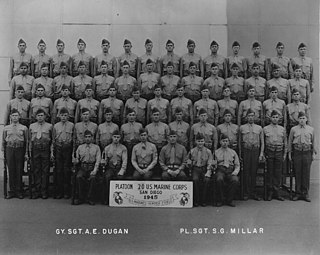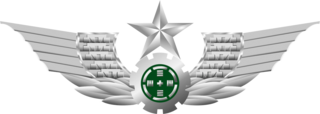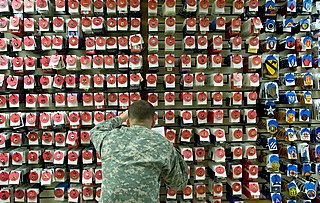The United States Armed Forces are the military forces of the United States. The armed forces consist of six service branches: the Army, Marine Corps, Navy, Air Force, Space Force, and Coast Guard. All six armed services are among the eight uniformed services of the United States.

The Portuguese Armed Forces are the military of Portugal. They include the General Staff of the Armed Forces, the other unified bodies and the three service branches: Portuguese Navy, Portuguese Army and Portuguese Air Force.
A division is a large military unit or formation, usually consisting of between 10,000 and 25,000 soldiers. In most armies, a division is composed of several regiments or brigades; in turn, several divisions typically make up a corps.

A battalion is a military unit, typically consisting of up to one thousand soldiers commanded by a lieutenant colonel and subdivided into a number of companies, each typically commanded by a major or a captain. The typical battalion is built from three operational companies, one weapons company and one headquarters company. In some countries, battalions are exclusively infantry, while in others battalions are unit-level organisations.
A company is a military unit, typically consisting of 100–250 soldiers and usually commanded by a major or a captain. Most companies are formed of three to seven platoons, although the exact number may vary by country, unit type, and structure.

A regiment is a military unit. Its role and size varies markedly, depending on the country, service, or specialisation.

A platoon is a military unit typically composed of two to four squads, sections, or patrols. Platoon organization varies depending on the country and the branch, but a platoon can be composed of 20–50 troops, although specific platoons may range from 10 to 100 people. A platoon is typically the smallest military unit led by a commissioned officer. The platoon leader is usually a junior officer—a second or first lieutenant or an equivalent rank. The officer is usually assisted by a platoon sergeant.

A brigade is a major tactical military formation that typically comprises three to six battalions plus supporting elements. It is roughly equivalent to an enlarged or reinforced regiment. Two or more brigades may constitute a division.

The People's Liberation Army Ground Force is the land-based service branch of the People's Liberation Army and the largest and oldest branch of the entire Chinese armed forces. The PLAGF can trace its lineage from 1927 as the Chinese Red Army; however, it was not officially established until 1948.
The Rapid Deployment Joint Task Force (RDJTF) is an inactive United States Department of Defense Joint Task Force. It was first envisioned as a three-division force in 1979 as the Rapid Deployment Force (RDF), a highly mobile rapid deployment force that could be rapidly moved to locations outside the normal overseas deployments in Europe and Korea. Its charter was expanded and greatly strengthened in 1980 as the RDJTF. It was inactivated in 1983, and re-organized as the United States Central Command (USCENTCOM).

A distinctive unit insignia (DUI) is a metallic heraldic badge or device worn by soldiers in the United States Army. The DUI design is derived from the coat of arms authorized for a unit. DUIs may also be called "distinctive insignia" (DI) or, imprecisely, a "crest" or a "unit crest" by soldiers or collectors. The U.S. Army Institute of Heraldry is responsible for the design, development and authorization of all DUIs.

The brigade combat team (BCT) is the basic deployable unit of maneuver in the U.S. Army. A brigade combat team consists of one combat arms branch maneuver brigade, and its assigned support and fire units. A brigade is normally commanded by a colonel (O-6) although in some cases a brigadier general (O-7) may assume command. A brigade combat team contains combat support and combat service support units necessary to sustain its operations. BCTs contain organic artillery training and support, received from the parent division artillery (DIVARTY). There are three types of brigade combat teams: infantry, Stryker, and armored.
A regimental combat team (RCT) is a provisional major infantry unit which has seen use by branches of the United States Armed Forces. It is formed by augmenting a regular infantry regiment with smaller combat, combat support and combat service support units.

Military organization (AE) or military organisation (BE) is the structuring of the armed forces of a state so as to offer such military capability as a national defense policy may require. Formal military organization tends to use hierarchical forms.

The Myanmar Army is the largest branch of the Armed Forces (Tatmadaw) of Myanmar and has the primary responsibility of conducting land-based military operations. The Myanmar Army maintains the second largest active force in Southeast Asia after the People's Army of Vietnam. It has clashed against ethnic and political insurgents since its inception in 1948.

The United States Army Aviation Branch is a combat arms branch within the United States Army and the administrative organization that is responsible for doctrine, manning and configuration for all army aviation units.
A headquarters and service company is a company-sized military unit, found at the battalion and regimental level in the U.S. Marine Corps. The U.S. Army equivalent unit is the headquarters and headquarters company.
The United States Marine Corps is tasked by Department of Defense directive to "conduct complex expeditionary operations in the urban littorals and other challenging environments" and "conduct amphibious operations, including engagement, crisis response, and power projection operations to assure access." Before 2006, the Marine Corps was the only branch of the Armed Forces that did not have any of its special warfare elements participating in the United States Special Operations Command (USSOCOM), due to confining its special operations capabilities only for the purpose to the Fleet Marine Force.

The United States armed forces classify reconnaissance missions as "close" or "short-range"; "distant" or "medium-range"; and "deep" or "long-range".











